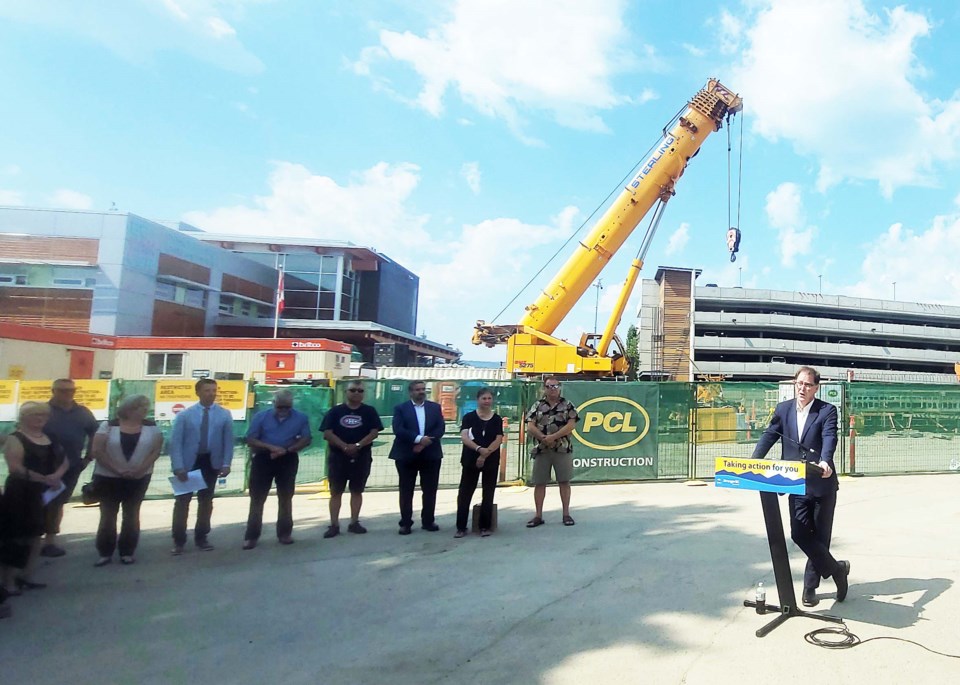The Fraser-Fort George Regional Hospital District board unanimously approved a capital expenditure bylaw committing $318.7 million to construct the acute care patient tower at the University Hospital of Northern BC.
In total, the district will contribute $365 million to the project. This sum includes $5 million already allocated for the business plan and $41.288 million designated for the early works agreement.
The regional district is expected to repay its 21.63 percent share of the $1.579 billion building cost over 20 to 30 years. Typically, regional hospital districts cover 40 percent of capital expenditures; however, a lower percentage was negotiated between the hospital board and the provincial government due to increased cost projections.
“It is expensive, and I don’t want to discount that, but we were able to negotiate an unprecedented deal with the province, a reduction of nearly 50 per of the amount or the legislatively required amount,” said Prince George Coun. Kyle Sampson, vice-chair of the hospital board.
“(Paying 40 per cent) is not only unaffordable but unfair to our local taxpayers and we were able to negotiate down to nearly 50 per cent of that and it’s locked in. We know that provincial projects often go over budget and our price, we’re locked in where we’re at.”
The regional district estimates the tower project will result in a minimum annual tax requisition increase of 2.60 per cent until 2049.
According to a presentation to directors, payment for a household living in an average-priced home is projected to rise to $451.84 as of 2039, up $151.13 from the $300.71 currently levied in the name of the Fraser-Fort George Regional Hospital District.
More specifically, the rate charged per $100,000 assessed value is projected to strike $111.12, up $37.17 from the current $73.95.
The hospital district debt financing is scheduled to start in 2029.
“We won’t contribute any money until (the province) spends at least $1 billion because we don’t want to borrow money up front for a project that’s golng to take probably at least five years to be completed,” said Prince George city councilor Brian Skakun, part of the 16-member hospital board.
Over the past decade, the hospital district has been preparing for the expansion by accumulating surplus funds.
The hospital board approval came after about a two-hour debate in Thursday’s meeting at the Regional District of Fraser-Fort George board room.
The funding was approved after the hospital board received written confirmation for the Ministry of Health that would not have to start paying until the province has already spent $1 billion on the tower project. That confirmation arrived just before Thursday’s meeting.
“What that meant for us was tens millions of dollars of savings,” said Sampson.
“We have a longer period of time to leave our deposits and investments and returns. We can service our debt over shorter periods of time with lower rates and we can hold off on paying that debt which means we aren’t paying on it as early. I was not going to vote yes unless we got that assurance from the ministry, which we finally did in the 11th hour.”
Formally announced last month by BC Health Minister Adrian Dix, the patient tower project will feature a surgical suite with five operating rooms and 47 new beds. It will also include a six-bed cardiac unit to centralize the hospital’s cardiac services and a 20-bed cardiac step-down unit for northern BC patients, who currently must travel to Vancouver, Victoria, or Kelowna for intensive cardiac care.
The 11-storey tower, to be built on the current site of the Northern Health Unit adjacent to the existing hospital, will add 36 treatment beds for UHNBC’s mental health and substance use services, increasing the total capacity to 83.
Overall, the addition will increase hospital capacity for cardiac, mental health, and surgical services by 109 beds, from 102 to 211.
Sampson was critical of the time it has taken the BC government to address upgrading the long-outdated patient facilities at UHNBC, the referring hospital for the entire northern half of the province.
“This is extremely disappointing that it has taken the provincial government this long to respond to the needs of the North and to have equitable access to healthcare for northern residents,” said Sampson.
“When this project was originally announced (in 2020) the contribution amount the regional district was expected to pay at 40 per cent was $125 million less than the amount we’re paying today,” he said.
“The inaction of the provincial government has led to a higher price tag for northern British Columbians.”
While trade agreements governing the procurement process prevent preferential treatment for local businesses on provincial projects, Skakun expressed optimism that local suppliers could benefit from the construction.
“We might be able to navigate around some of these trade agreements by getting contractors to commit to using local and regional businesses and labour,” Skakun said.
“When we did the Canfor Leisure Pool, Chandos Construction committed to using local tradespeople or businesses,” he noted.
“I’ve spoken with a few businesses and organizations to ensure that once we know the bid process and winning bidders, we can approach companies doing the work. Many local businesses could contribute to the project — electricians, millwrights, and other trades. If we are organized and prepared, it’s a huge opportunity for our community and region.”
Construction of the tower is slated to begin in early 2026, with the tender procurement process through BC Bid expected to open sometime next year.



